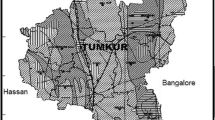Abstract
In this paper, we present the variation of natural radioactivity in soil and water samples of Tehri Garhwal district of Garhwal Himalaya. The soil and water samples collected from different locations were studied and analyzed using Gamma ray spectrometry and Laser Fluoremetry techniques, respectively. The activity concentrations 226Ra, 232Th and 40K in the soil samples were found to vary 31 ± 6 to 67 ± 7 Bq kg−1 with an average 46 Bq kg−1, 38 ± 7 to 86 ± 10 Bq kg−1 with an average of 52 Bq kg−1 and 612 ± 120 to 1277 ± 168 Bq kg−1 with an average of 902 Bq kg−1, respectively. Uranium concentration in water samples was found to vary from BDL to 2 ppb with an average 0.6 ppb. The above measured values uranium in drinking water ware also be compare the uranium concentrations in drinking water in Ukimath area. The measured values of activity concentrations in the soil and water samples were found within permissible limits.






Similar content being viewed by others
References
Quindos LS, Fernadez PL, Soto J, Rodenas C, Gomes J (1994) Natural radioactivity in Spanish soil. Health Phys 66:194–200
Devi V, Chauhan RP (2020) Estimation of natural radionuclide and exhalation rates of environmental radioactive pollutants from the soil of northern India. Nucl Eng Technol 52(6):1289–1296
Shahrokhi A, Adelikhah M, Chalupnik S, Kovács T (2021) Multivariate statistical approach on distribution of natural and anthropogenic radionuclides and associated radiation indices along the north-western coastline of Aegean Sea Greece. Mar Pollut Bull 163:112009
Chowdhury CR, Khijmatgar S, Chowdhury A, Kumari PD, Lynch E, Gootveld M (2020) Radionuclide activity concentration in soil, granites and water in a fluorosis endemic area of India: an oral health perspective. J Oral Bio Craniofacial Res 10(3):259–262
UNSCEAR (2000) Sources, effects and risks of ionizing radiation I United Nations scientific committee on the effects of atomic radiation New York
World Health Organization (WHO) 2004 Guidelines for drinking-water quality 3 WHO Geneva
World Health Organization (WHO) 2011 Guidelines fo drinking-water quality 4 WHO Geneva
Dosseto A, Turner SP, Douglas GB (2006) Uranium-series isotopes in colloids and suspended sediments: timescale for sediment production and transport in the Murray-Darling River system. Earth Planet Sci Lett 246:418–431
Porcelli D, Andersson PS, Baskaran M, Wasserburg GJ (2001) Transport of U- and Th- series nuclides in a Baltic shield watershed and the Baltic Sea. Geochimica et Cosmohinica Actu 65:2439–2459
Ramola RC, Choubey VM, Prasad G, Gusain GS, Tosheva Z, Kies A (2011) Radionuclide analysis in the soil of Kumaun Himalaya India using gamma ray spectrometry. Current Sci 100(6):906–911
Somboon S, Inoue K, Fukushi M, Tsuruoka H, Shimizu H, Kasar S, Arae H, Kavasi N, Sahoo SK (2019) Distribution of uranium in Japanese river waters determined with inductively coupled plasma mass spectrometry. J Radioanal Nuclear Chem 319:1307–1314
Giammar D (2001) Geochemistry of uranium at mineral-water interfaces: rates of sorption-desorption and dissolution-precipitation reactions. Ph.D. Dissertation California Institute of Technology, (http://resolver.caltech.edu/CaltechETD: etd-05212002–125705)
Paiva JDS, Farias EE, de Franca EJ (2015) Assessment of the equilibrium of Th-228 and Ra-228 by gamma-ray spectrometry in mangrove soils. INAC 2015: international nuclear atlantic conference Brazilian nuclear program State policy for a sustainable world, Brazil
Shahrokhi A, Kovacs T (2021) Radiological survey on radon entry path in an underground mine and implementation of an optimized mitigation system. Environ Sci Eur 33:66
Singh S, Rani A, Mahajan R (2005) 226Ra, 232Th and 40K analysis in soil samples from some areas of Punjab and Himachal Pradesh, India using gamma ray spectrometry. Radiat Meas 39:431–439
Sharma T, Sharma A, Kaur I, Mahajan RK, Litoria PK, Sahoo SK, Bajwa BS (2019) Uranium distribution in groundwater and assessment of age dependent radiation dose in Amritsar Gurdaspur and Pathankot districts of Punjab, India. Chemosphere 219:607–616
Singh S, Bajwaa BS, Kaurb I (2021) (Zn/Co)-zeolitic imidazolate frameworks: room temperature synthesis and application as promising U(VI) scavengers A comparative study. J Ind Eng Chem 93:351–360
Tufail M (2012) Radium equivalent activity in the light of UNSCEAR report. Environ Monit Assess 184:5663–5667
Yadav M, Rawat M, Dangwal A, Prasad M, Gusain GS, Ramola RC (2014) Levels and effects of natural radionuclides in soil samples of Garhwal Himalaya. J Radioanaly Nuclear Chem 302:869–873
Yadav M, Rawat M, Dangwal A, Prasad M, Gusain GS, Ramola RC (2015) Analysis of natural radionuclides in soil samples of purola area of garhwal himalaya India. Radiation Protect Dosimet. https://doi.org/10.1093/rpd/ncv247
UNSCEAR (2008) United nation scientific committee on the effects of atomic radiation effects and risks of ionizing radiations, Annex B, United Nations, New York
OECD (1979) Organization for economic cooperation and development. Exposure to radiation from the natural radioactivity in building materials. Report by a Group Experts of the OECD Nuclear Energy Agency. Paris, France
Rich RA, Holland HD, Petersen U (eds) (1980) Hydrothermal uranium deposits. Elsevier, Amsterdam
Author information
Authors and Affiliations
Corresponding author
Additional information
Publisher's Note
Springer Nature remains neutral with regard to jurisdictional claims in published maps and institutional affiliations.
Rights and permissions
About this article
Cite this article
Yadav, M., Prasad, M., Dutt, S. et al. Variation of natural radioactivity in soil and water samples of Garhwal Himalaya, India. J Radioanal Nucl Chem 331, 1951–1958 (2022). https://doi.org/10.1007/s10967-021-08147-3
Received:
Accepted:
Published:
Issue Date:
DOI: https://doi.org/10.1007/s10967-021-08147-3




